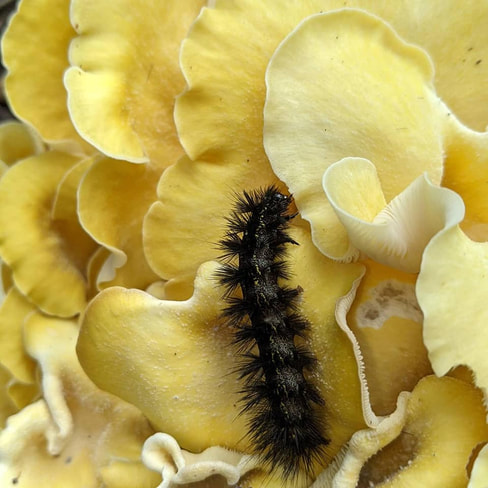 I captured this caterpillar chilling on golden oysters growing at Zilker Botanical Garden in our strawberry and asparagus, mushroom garden bed. I did a quick iNaturalist search to learn it is a Salt Marsh Moth, Estigmene acrea. This app is a great tool for researching and identifying good and bad insects. You can see multiple pictures of insects at their various stages of life, and descriptions from Wikipedia. It even gives you a breakdown of where else insects have been observed in your area on a map. The caterpillar is beautiful as a moth, and as a growing caterpillar clearly had an appetite for nitrogen rich vegetables. They were also devouring the leaves of the fava beans that were nearby. We contemplated why one of the caterpillars was a fungivore. Definitely has good tastes. This lucky caterpillar struck gold in finding an even more appetizing meal. We decided to allow these caterpillars to continue to enjoy their meal. Learn more about how to grow mushrooms in the garden here. From Texas A&M:
Despite the name, salt marsh caterpillars can show up in many different habitats other than salt marshes. They eat a wide variety of plants and are found all across the United States. In some places, like southwest United States, these caterpillars can damage crops. Salt marsh caterpillars skeletonize the plants they feed on, leaving only the main leaf veins. Older caterpillars eat large holes in the leaves and become more solitary. They can go great distances in search for food and can sometimes travel in large numbers. Salt marsh caterpillars do not bite and are not poisonous. Related: Don’t miss our next online guest, Jay White, the publisher of Texas Gardener Magazine who will be presenting more on this topic with his “Pest-free Organically” presentation on May 10th at 6 PM CST.  We just passed the Full Pink Super Moon, theSprouting Grass Moon, the Egg Moon, the Fish Moon, the Paschal Moon, Hanuman Jayanti, Bak Poya, and a Supermoon. So many interpretations of the full moon around the world. We are now going into a waning period of the Moon—from the day after it is full to the day before it is new again. As the moonlight decreases night by night, plants are encouraged to grow roots, tubers, and bulbs. It’s always best to try to plant with the coming rains which are in the forecast. Click on the links to get growing information and best varieties from Texas A&M Extension and other sources. ROOT CROPS Sweet Potatoes (Slips) GROW YOUR OWN You can plant sweet potato slips through June so you still have a little time to grow your own slips at home. See our blog post on two ways to do this at home. The method that produced the most slips was the “soil method.” There were approximately 25 slips created from one sweet potato. SLIP GIVEAWAY We have so many purple sweet potato slips left over from the soil method that we decided to do a give-away. The first person to respond to our email by April 28, 2021, with the correct answer to the following question wins! What family is the Sweet Potato in? Pick-up is in Central East Austin (78702). WHERE TO BUY If you haven’t grown your own slips you can buy them at local nurseries such as The Natural Gardener and Tillery Plant Company. You can even plant small organic sweet potatoes directly in the soil. For more ideas on Ornamentals, Perennials, and Herbs, visit the Central Texas Gardener and The Natural Gardener lists online. Download the Texas A&M Extension Planting Chart and Varieties Chart at AustinOrganicGardners.org. 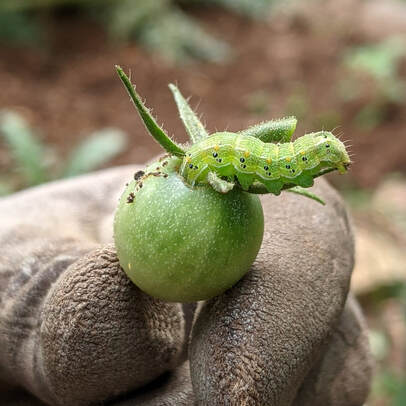 This past Saturday we found a green, spotted caterpillar that was devouring one of our sungold tomatoes at the teaching gardens Zilker Botanical Garden. Caterpillars like this and the tomato hornworm, can be a major pest in gardens.They also feed on other plants in the Solanaceae (nightshade) family: eggplants, peppers, tobacco, and potatoes. They blend in quite easily with the green foliage and feed non-stop, creating spotty and chewed leaves and fruit HOW TO GET RID OF TOMATO WORMS 👌Handpicking - The caterpillars can neither sting nor bite. If you are squeamish about crushing these large insects, drop them into soapy water instead (or feed them to your chickens.) 🧼Insecticidal soaps will also kill hornworms, but the pests need to come into direct contact with the substance. 🌻Increase Plant Diversity: Plant crops that attract natural predators of caterpillars such as wasps, lacewings, birds, lady bug beetles, and spiders. Plant things like sunflowers, marigolds, buckwheat and mulch with straw or leaf mulch to give a home for these insects in your garden. 🐛Insecticides should be a last resort. You can use the organic pesticide Bt (Bacillus thuringiensis), which is a bacterium that acts as a stomach poison on some larval insects (but doesn’t harm other plants or animals). Bt must be ingested by the caterpillars to be effective, and it must be reapplied to plant foliage after rain. NEXT ONLINE EVENT Don’t miss our next online guest, Jay White, the publisher of Texas Gardener Magazine who will be presenting more on this topic in his “Pest-free Organically” talk on May 10th at 6 PM CST. BECOME A MEMBER All of our online education FREE and we are always looking for new members to help us support our mission. Visit AustinOrganicGardeners.org to become a member of the oldest organic garden club in America. Memberships are only $10 a year and 100% of dues go to the Zilker Botanical Garden. BONUS: AOG Members get a discount code for a subscription to Texas Gardener Magazine. 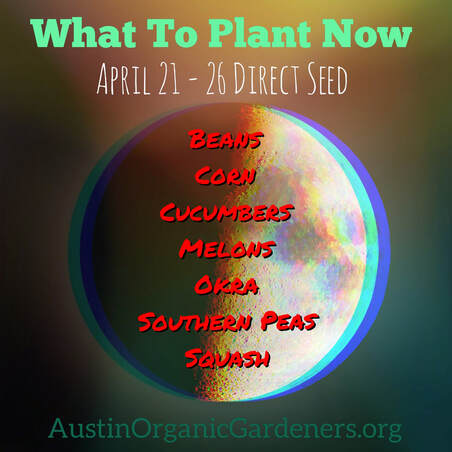 We just passed the first quarter and the moon is now in waxing gibbous going into a full moon. Now is also a time to seed-in plants that fruit and seed like beans, corn, cucumbers, watermelon, cantaloupe, pumpkins, squash, okra, and southern peas. Their is still time for transplants of strawberries, eggplants, tomatillos, tomatoes and peppers. Also time to plant nut and fruit trees including citrus, and berry bushes and grape vines. It’s always best to try to transplant and seed-in with the coming rains. Which is coming this week. DIRECT SEED
This is your last chance to plant corn until late summer. For this year's three sisters at Zilker Botanical Garden, we planted heirloom, glass gem corn with Royal Burgundy pole beans, and tatume squash. The squash will start to vine out and protect the soil as the heat increases. Around the perimeter we planted Oaxaca Red Epazote (thanks for the donation Danielle), Habanero Lemon peppers (thanks Sunshine Community Gardens), Hopi Black Dye Sunflowers and Mexican Marigolds. TRANSPLANT
If you haven’t gotten your night shades in, AOG Member and grower from our plant sale, Erin Hollis has a bunch left that she is giving away. Join our Facebook Group Austin Organic Gardeners and learn how to get them. FRUITING / NUT PLANTS
For more ideas on Ornamentals, Perennials, and Herbs, visit the Central Texas Gardener and The Natural Gardener lists online. Download the Texas A&M Extension Planting Chart and Varieties Chart on our website. +++ Become a member of the oldest organic gardening club in the U.S. Memberships are only $10 a year and 100% of your dues support Zilker Botanical Garden. Related Content In this video Charlotte from the SCG Education Team gives a breakdown of Sunshine Community Garden’s custom recipe for refreshing raised bed soil that has been depleted or sitting without proper protection from the Texas heat. This volunteer project by members of the Sunshine Community Gardens was at the Texas School for the Blind and Visually Impaired Garden which is also located at Sunshine. This soil refresh recipe is perfect for school or community garden beds, container gardens, or any raised beds that have been sitting unused for a period of time. Many of these tips apply to all soil amending in central Texas, even for in ground beds. PLANNING
RECIPE The following is Sunshines Community Garden’s custom soil refresher recipe. It does not require precision and the amounts are approximate. Major components 6 – 10 parts spent (previous/old) old bedding mix 4 - 5 parts compost 1 part rice hulls (premoistened) 1 part shredded coconut coir (premoistened overnight if possible) ½ part kelp meal (i.e., use ½ to all of a 5lb box from Down To Earth) ½ part perlite (optional, i.e., use ½ to all of an 8-quart bag) ½ part diatomaceous earth (optional) Mineral Amendments Add by the cup or by the handful. Use product packaging or the internet for reference:
Optional Amendments Best added on top of refreshed soil for more immediate availability:
BREAKDOWN IN STEPS STEP 1: On a tarp, remove old soil from beds into piles of around one-fourth cubic yard each (30-40 gallons) to make mixing easier. In the video we give a suggestion for cases when it is not possible to amend all of the old soil by inserting the compostable layer (normally at the bottom of a raised bed) above any soil that will not be amended. Amend 100% of shallow beds but 50-70% of deeper beds is fine if you have time or budget limitations. STEP 2: Next to the pile of old bedding mix, start with a separate pile, with compost, close to the same size (20-30 gallons.) Any type of organic compost works and we chose to use turkey compost. STEP 3: Add a significant amount of nitrogen-rich structural amendments that will break down more QUICKLY (in 1-2 seasons.) These types of organic matter are often agricultural by-products and can be free or inexpensive. Follow our recipe, product packaging or internet to determine the amount to add. While certain amendments (like rice hulls, coconut coir or diatomaceous earth) are best pre-moistened before adding them, it is easier to mix your piles if everything is drier.
STEP 4: Add a significant amount of structural amendments that break down SLOWLY such as coco coir, peat moss, perlite and vermiculite. Follow our recipe, product packaging or internet to determine the amount to add.
STEP 5: Add minerals & silica for nutrition and cell structure. Follow our recipe, product packaging or internet to determine the amount to add.
STEP 6: Mix enriched pile of amendments until all components are uniformly distributed. STEP 7: Combine old soil with enriched amendment pile. As you return your refreshed bedding mix to your box or containers, moisten each layer as you go so that your final result is moist enough to form a loose but distinct clump when squeezed in your hand. STEP 8: Add cardboard on bottom of the bed or on top of left-over soil. This prevents weeds and adds more worm food. STEP 9: Add leaves or other brown and green debris (carbon) and coffee (attracts worms) on top of cardboard. Water this layer. STEP 10: Fill bed with half of the renewed bedding mix, followed by a watering, and then fill with remainder with another watering. STEP 11: Top mulch the bed with any of the following types of mulch to help retain moisture. Some of these will continue to add nutrients to the soil:
MORE ORGANIC AMENDMENTS SEAWEED OR KELP MEAL – Seaweed or Kelp Meal adds potassium (K), trace minerals, salts, alkalinizing the soil. It's an excellent bioactivator, waking the microbes in the soil to help break down organic matter. SEAWEED SPRAY (alkalinizing) Alternatively, mix in a few handfuls of dried kelp meal. Supposedly helps with heat tolerance but cannot find a reference for that yet. NOTE: Excessive potassium or potash will decrease the soil's acidity so use it in a balanced way.) FISH EMULSION – A fast-acting, organic liquid fertilizer made from the byproducts of the fishing industry. It is rich in nitrogen, phosphorus and potassium, plus trace elements such as calcium, magnesium, sulfur, chlorine, and sodium. SHRIMP MEAL – nitrogen, phosphorus, calcium, and chitin CRAB MEAL, OYSTER OR LOBSTER – nitrogen, phosphorus, calcium, and chitin BONE MEAL – phosphorus “roots and fruits” BLOOD MEAL – nitrogen “greening the giant” ORGANIC N-P-K SLOW-RELEASE GRANULES – Down to Earth or Jobe’s WORMS WORM CASTINGS INSECT FRASS – Mealworm castings, cricket frass, is simply the feces of the insect. ROCK DUST (and/or regular sand) – very slow-release minerals and SOME water retention. (Less sophisticated than Azomite, Excelerite or Green Sand) LIME - Generally not needed in central Texas because it is too alkalinizing AMENDMENTS THAT CAN BE CONFUSING Biochar (alkalinizing) “potash”– If you're adding potassium to decrease the soil's acidity, use 1 to 2 pounds of hardwood ash per 100 square feet of soil. Other ways to add potassium are: add cut up banana peels and bury them 1 to 2 inches down in the soil or mix in a few handfuls of dried kelp meal or spray the soil with a liquid seaweed spray. Coffee grounds – Brewed grounds are pH neutral but they do consume nitrogen as they decompose and compete with growing crops…but worms are mad for them. Some gardeners drop into vertical “wells” so worms can visit without significant contact with growing plant roots. ONLY UNBREWED COFFEE GROUNDS ARE ACIDIC. More Epsom Salt for tomatoes, peppers or calcium loving plants at the time of transplant and for maintenance Food Grade Diatomaceous Earth (FG-DE) is derived from fossilized remains of algae-like, single-cell plants called diatoms. Diatoms are some of the oldest plants in the world. They date back millions of years. These plants left behind chalky deposits called diatomite which is ground into a powder and purified for the consumer market. Chemically speaking, diatomaceous earth is 84% silica, and contains some 20 trace minerals, including small percentages of magnesium, sodium, iron and a good dose of calcium in the right ratio with magnesium for good utilization in building structures such as cell walls for healthy leaves and stems. In humans and animals, silica is essential for the building of healthy bones and teeth, skin, hair, and nails. FG-DE is often used in the garden as a natural pest control substance. However, it can harm bees, other pollinators and ladybugs so use proper precautions as needed to reduce the chances of harm such as only using when needed for a specific pest, not over applying and avoiding use on vegetables and pollinator plants that are flowering. Many studies have also been conducted to analyze the effect that FG-DE has as a soil amendment. These studies have shown promising results, suggesting that diatomaceous earth may significantly enhance nutrient retention and moisture retention in soil. https://www.absorbentproductsltd.com/food-grade-diatomaceous-earth-as-a-soil-amendment/ So far the conclusion is that diatomaceous earth doesn’t harm most beneficial microorganisms in the soil. Worms, for example, are not affected by the microscopic edges in diatomaceous earth particles. WHERE TO BUY AMENDMENTS We recommend the following local garden store for many of the amendments in our recipe. Austin Organic Gardeners, Sunshine Community Gardeners and other Austin area community gardeners are eligible to receive a discount at: Brite Ideas Aquaponics, Hydroponics and Organics South Austin (NEW LOCATION) 12110 Manchaca Rd. Ste. 103 Austin, TX 78748 Local: 512.444.2100 Owner: Troy Smith SOUTH AUSTIN STORE HOURS (CLOSED ON MONDAYS) Tuesday-Friday 10:00 am – 6:00 pm Saturday 10:30 am – 5:00 pm Sunday 12:00 pm – 4:00 pm This past Saturday we said goodbye to our winter cover crop. It was beautiful to see the blooms of the hairy vetch and peas attract beneficial insects like ladybugs and then the mustards and radishes trapped pests like aphids and provided food for the ladybugs as they mated. We planted the cover crop mix of winter rye, peas, mustards and daikon radishes in a compacted and depleted area that was once a path. Before everything went fully to seed, we cut the stems at the base and then, trench composted the "green manure." Never, uproot any of you crops because you don't want to upset the soil ecosystem or pull up the organic matter and nitrogen nodules that are in the roots of the plants. To keep the soil protected as the weather warms, we planted a summer cover crop blend of buckwheat, sorghum and millet. See our previous post to get cover crop ideas for your garden. To learn about the benefits of cover crops, watch this episode from he fall video series. GROW WITH US Austin Organic Gardeners member volunteer day at Zilker Botanical Gardens teaching gardens is on Saturday mornings from 9 to 11 a.m. Volunteering in the teaching garden is a safe way to social distance, get outdoors, and also learn how to organic garden. We are also looking for seed and plant donations so let us know if would like to contribute to the garden this way. Please email us and let us know if you can grow with us. We transplated glass gem corn and tatume squash in our milpa mounds (also known as Three Sisters) this past Saturday. In a few weeks we will plant an heirloom variety of purple pole beans. The pole beans will climb the corn and help support it. The squash will start to vine out and protect the soil as the heat increases. Around the perimeter we planted Oaxaca Red Epazote (thanks for the donation thanks Danielle), Habanero Lemon peppers (thanks Sunshine Community Gardens ), Hopi Black Dye Sunflowers and Mexican Marigolds. We will water weekly with fish emulsion fertilizer to encourage green growth. It is rich in nitrogen, phosphorus and potassium, plus trace elements such as calcium, magnesium, sulfur, chlorine, and sodium. As things warm up, we will use seaweed kelp to help de-stress. Liquid kelp fertilizer appears to be a miracle product when used on almost any plant: 🌊 Many fruits become sweeter 🦞 Veggies are less prone to softening and often grow larger 🐙 Increases flower production on flowering plants 🐠 Increases overall plant resilience to disease 🦑 Cut flowers stay fresh longer 🐚 Encourages root growth, both in rate and root massma 🍤Fruits and vegetables survive longer post-harvest if treated with seaweed fertilizer pre-harvest This garden is inspired by our special guest from March, Sam Dixza Rugs & Organic Farm and the cloud people from central valley in Oaxaca, Mexico. The native people have been using this crop-growing system used throughout Mesoamerica for 10,000 years. If you missed Sam's talk last month, you can watch it here. GROW WITH US
Austin Organic Gardeners member volunteer day at Zilker Botanical Gardens teaching gardens is every Saturday mornings from 9 to 11 a.m. Volunteering in the teaching garden is a safe way to social distance, get outdoors, and also learn how to organic garden. We are also looking for seed and plant donations so let us know if would like to contribute to the garden this way. Please email and let us know if you can grow with us. 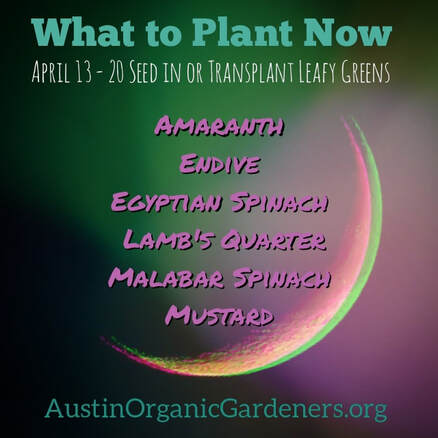 Seed In or Transplant Leafy Greens, Cereals, and Herbs We just passed the New Moon phase and are now approaching the First Quarter and are in Waxing Crescent. It’s a good time to plant leafy greens, cereal grains, and herbs that do well in heat. During the waxing of the moon (the period extending from the day the moon is new to the day it reaches its fullest point), the moon pulls moisture upwards. Seeds do well during this time because moisture is available at the surface of the soil. It’s always best to try to transplant and seed-in with the coming rains. Keep dancing for the rain that is in the forecast. As things cool back down this week, it will be a great time to plant these warm season greens, cereal grains, and herbs. Seed-in or Transplant Warm Season Greens
Seed in Cereal Grains & Cover Crops For the health of your soil, moisture retention, and to prevent weeds, keep your soil covered at all times with cover crops, compost and mulch. Bare soil invites weeds. Consider planting summer cover crops, such as buckwheat or black-eyed peas, or flax. Add compost, then mulch, to other bare soil areas. An inch or two of compost, and then two or three inches of mulch.
Transplant or Seed-in Herbs
A lot of herbs were damaged in the snow storm. If yours are not showing signs of life, here are some warm season herbs that can be transplanted.
For more ideas on Ornamentals, Perennials, and Herbs, visit the Central Texas Gardener and The Natural Gardener lists online. Download the Texas A&M Extension Planting Chart and Varieties Chart on our website.
Just in time for the April showers, comes our first video in our Spring Gardening Video Series. We will be sharing monthly tips from the teaching gardens at Zilker Botanical Gardens through the spring into early summer.
|
AuthorWrite something about yourself. No need to be fancy, just an overview. Archives
May 2024
Categories |




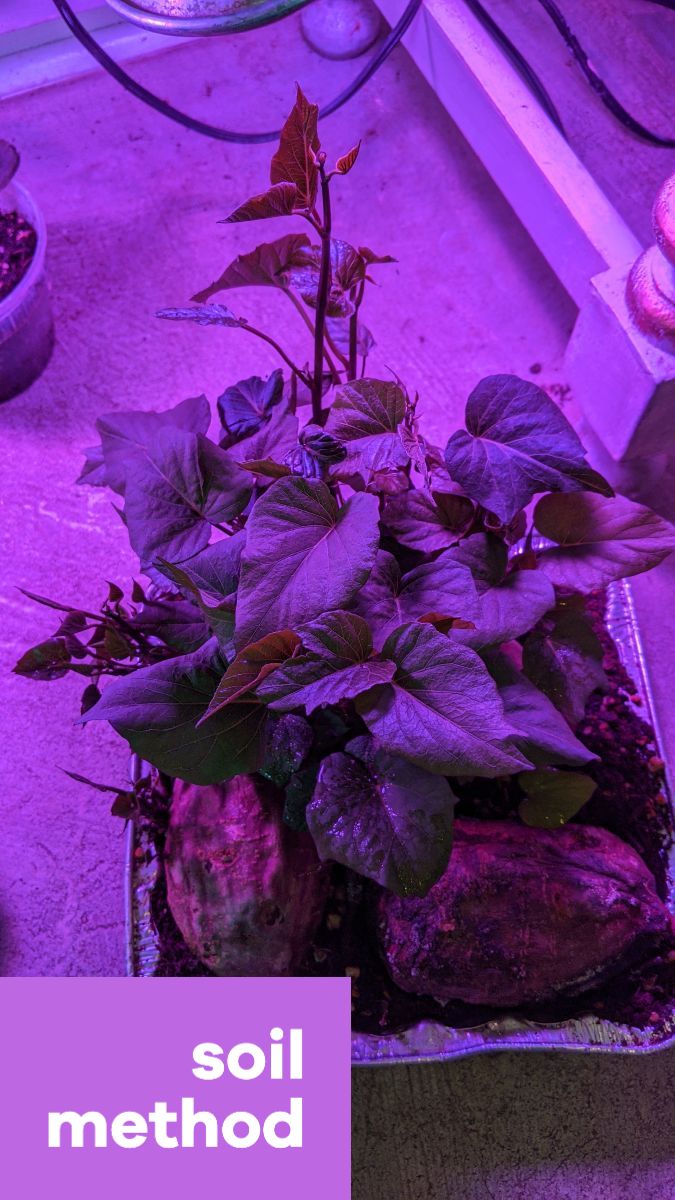
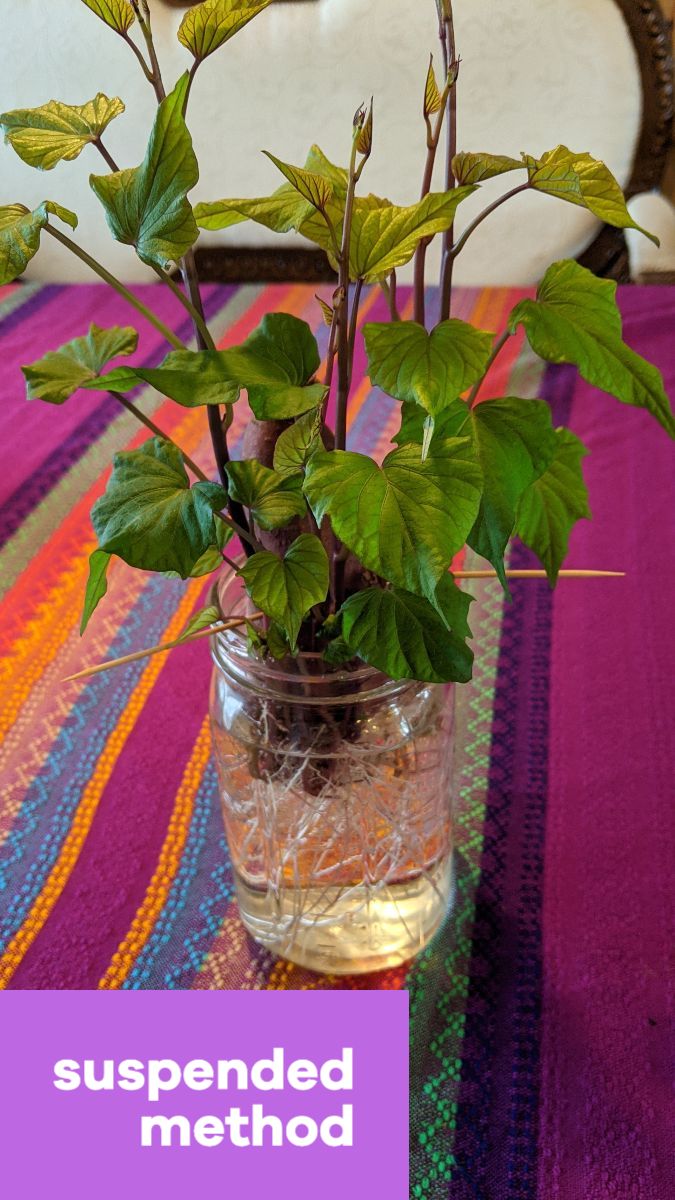




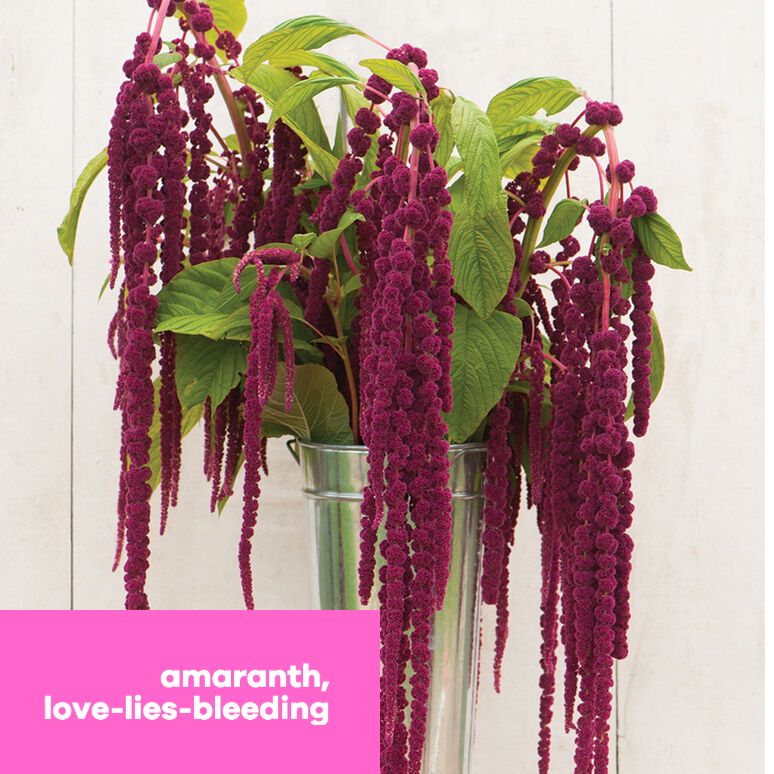
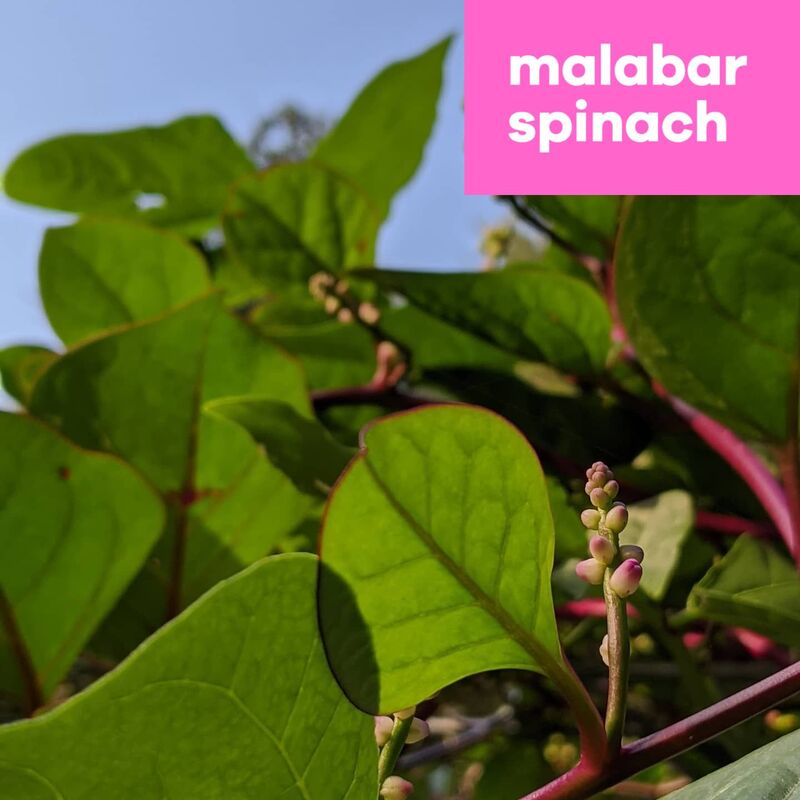
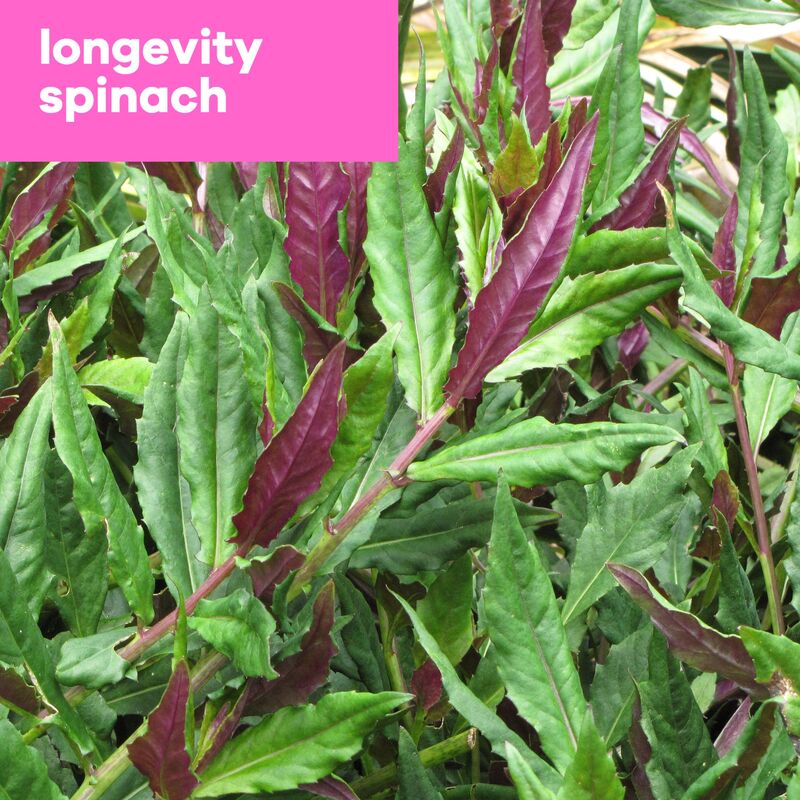
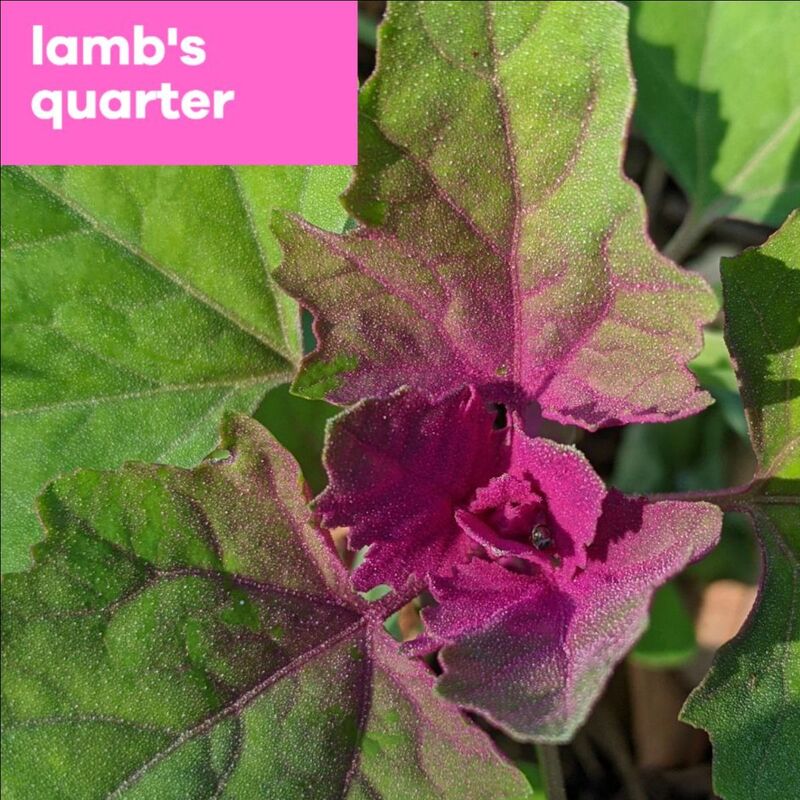
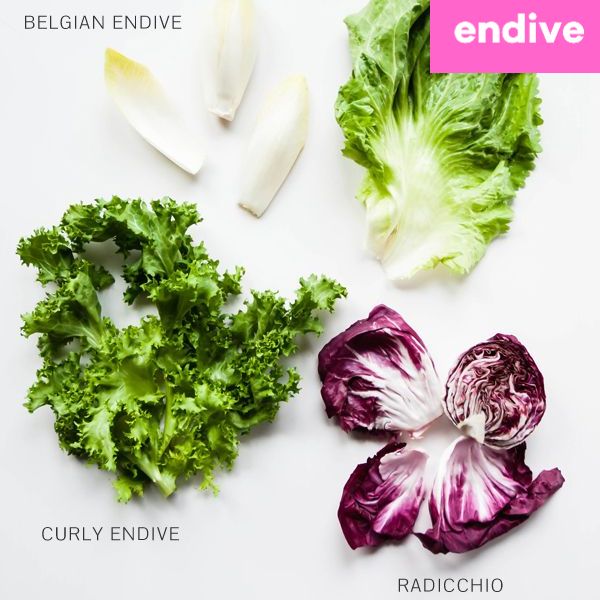
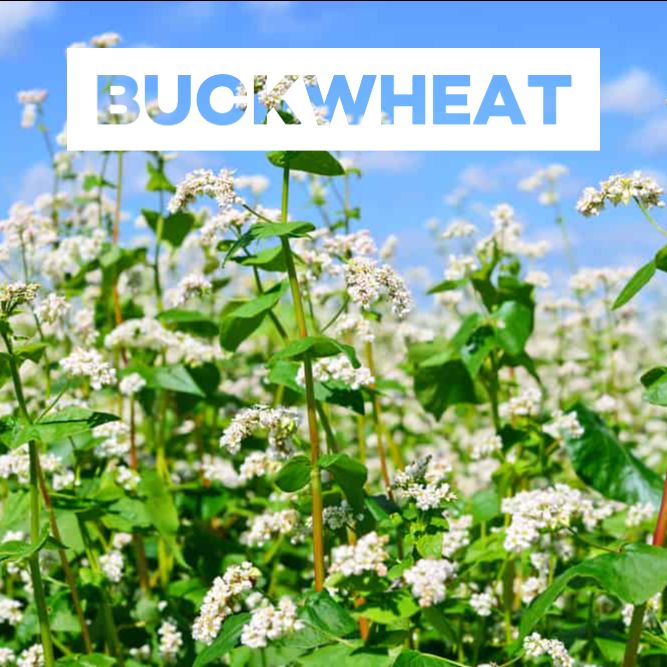
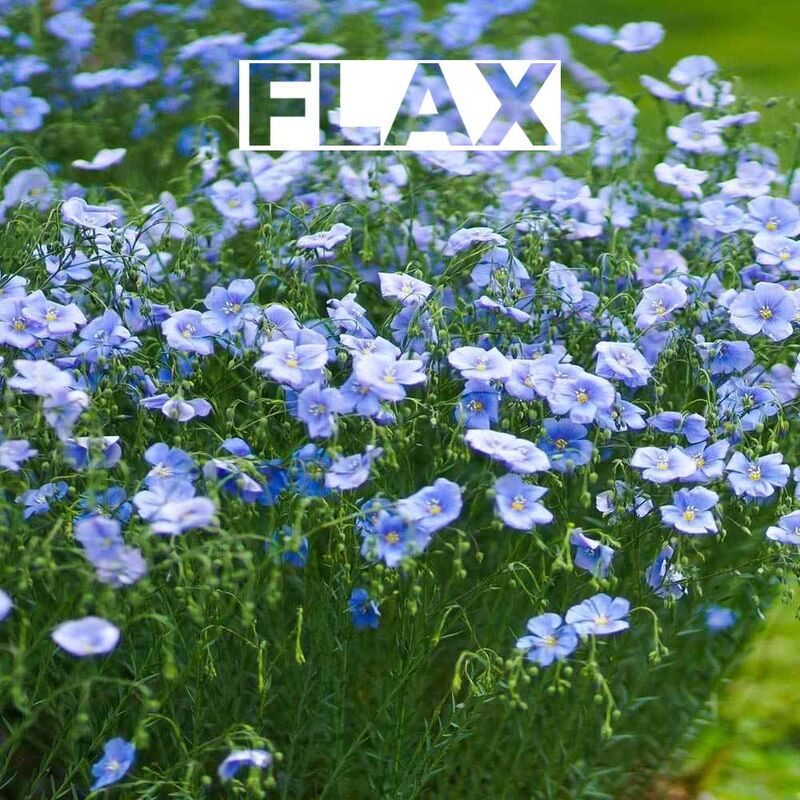
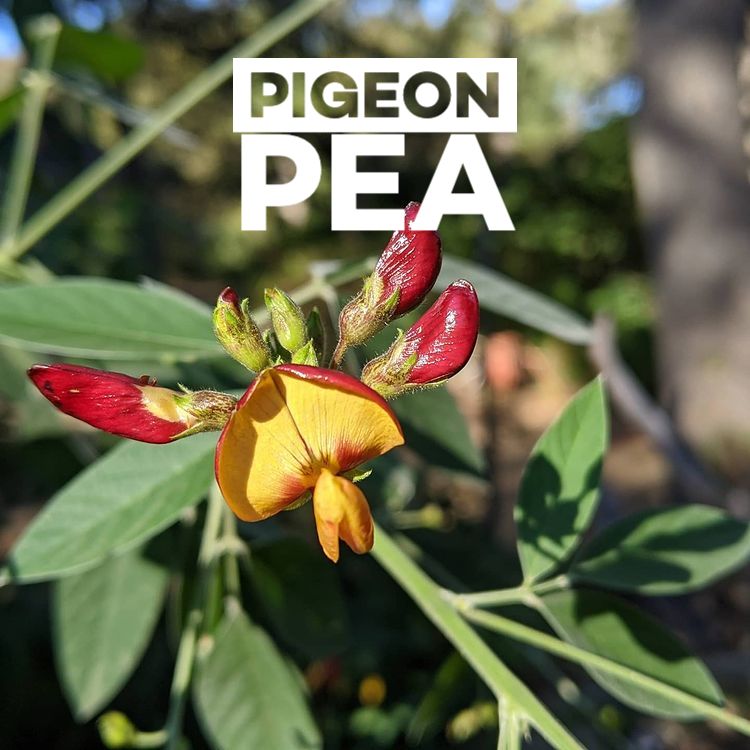
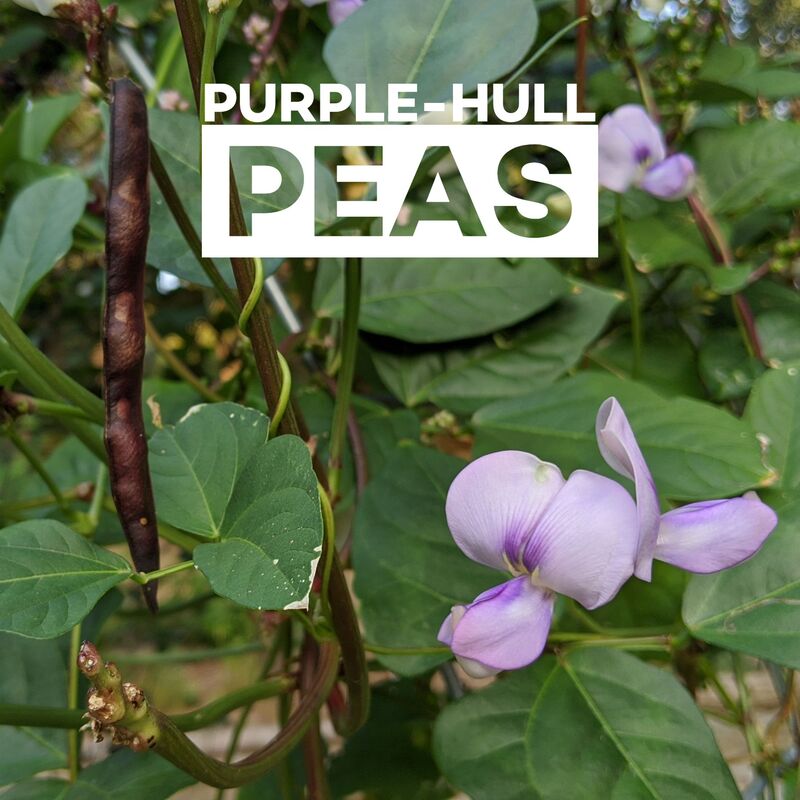
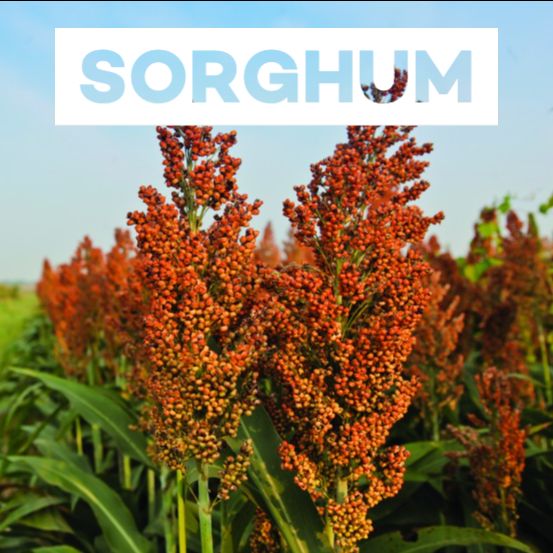
 RSS Feed
RSS Feed